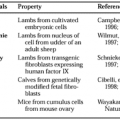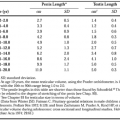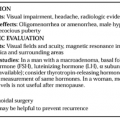THYROID-HORMONE RECEPTORS AND THEIR STRUCTURE
Two related TRs, which have been identified, bind TH with high affinity and specificity6,7; these TRs, initially called c-erbAs, are protooncogenes of a previously described viral oncogene product, v-erbA, that causes erythroblastosis in chicks. On the basis of amino-acid sequence homology and similarity in the organization of functional domains of receptors, TRs belong to a large superfamily of nuclear-hormone receptors that include the steroid hormone, vitamin D, and retinoic acid receptors.
Like the other family members, TRs contain a central DNA-binding domain with two “zinc finger” motifs and a carboxy-terminal ligand-binding domain8,9 (Fig. 31-2). The ligand-binding domain is important for ligand binding and also for transactivation and dimerization. X-ray crystallographic studies of liganded
TR have shown that TH is embedded in a hydrophobic pocket flanked by discontinuous stretches of the ligand-binding domain.10 A subregion important for transcriptional activation (AF-2)11,12 also exists at the extreme carboxy terminus. This subregion is highly conserved within the nuclear-hormone receptor superfamily and appears to undergo a major conformational change on ligand binding.11,12 The ligand-binding domain contains at least nine hydrophobic, heptad repeats, which potentially may be involved in TR homo- and heterodimerization.13 Mutations in the ninth heptad region abrogates TR heterodimerization, thus suggesting that this may be a particularly important region for dimerization. The hinge region between the DNA- and TH-binding domains contains a nuclear-localization motif common among nuclear-hormone receptors.8,9 However, unlike steroid-hormone receptors, which associate with cytoplasmic heat shock proteins in the absence of ligand, TRs are localized predominantly in the nucleus and bind DNA even in the absence of ligand.
TR have shown that TH is embedded in a hydrophobic pocket flanked by discontinuous stretches of the ligand-binding domain.10 A subregion important for transcriptional activation (AF-2)11,12 also exists at the extreme carboxy terminus. This subregion is highly conserved within the nuclear-hormone receptor superfamily and appears to undergo a major conformational change on ligand binding.11,12 The ligand-binding domain contains at least nine hydrophobic, heptad repeats, which potentially may be involved in TR homo- and heterodimerization.13 Mutations in the ninth heptad region abrogates TR heterodimerization, thus suggesting that this may be a particularly important region for dimerization. The hinge region between the DNA- and TH-binding domains contains a nuclear-localization motif common among nuclear-hormone receptors.8,9 However, unlike steroid-hormone receptors, which associate with cytoplasmic heat shock proteins in the absence of ligand, TRs are localized predominantly in the nucleus and bind DNA even in the absence of ligand.
Stay updated, free articles. Join our Telegram channel

Full access? Get Clinical Tree






